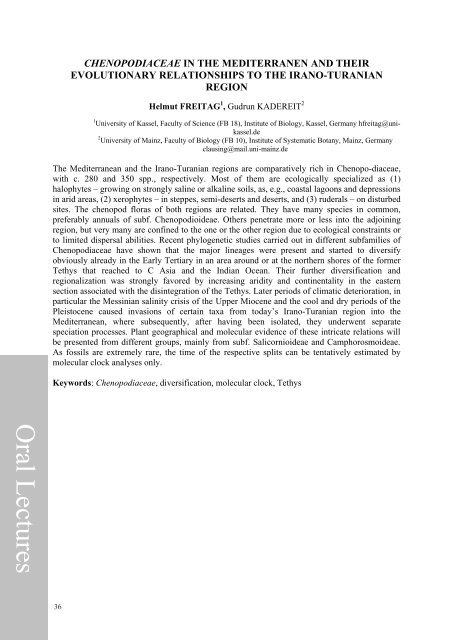Adil GÜNER, Vehbi ESER - optima
Adil GÜNER, Vehbi ESER - optima
Adil GÜNER, Vehbi ESER - optima
You also want an ePaper? Increase the reach of your titles
YUMPU automatically turns print PDFs into web optimized ePapers that Google loves.
Oral Lectures<br />
36<br />
CHENOPODIACEAE IN THE MEDITERRANEN AND THEIR<br />
EVOLUTIONARY RELATIONSHIPS TO THE IRANO-TURANIAN<br />
REGION<br />
Helmut FREITAG 1 , Gudrun KADEREIT 2<br />
1 University of Kassel, Faculty of Science (FB 18), Institute of Biology, Kassel, Germany hfreitag@unikassel.de<br />
2 University of Mainz, Faculty of Biology (FB 10), Institute of Systematic Botany, Mainz, Germany<br />
clausing@mail.uni-mainz.de<br />
The Mediterranean and the Irano-Turanian regions are comparatively rich in Chenopo-diaceae,<br />
with c. 280 and 350 spp., respectively. Most of them are ecologically specialized as (1)<br />
halophytes – growing on strongly saline or alkaline soils, as, e.g., coastal lagoons and depressions<br />
in arid areas, (2) xerophytes – in steppes, semi-deserts and deserts, and (3) ruderals – on disturbed<br />
sites. The chenopod floras of both regions are related. They have many species in common,<br />
preferably annuals of subf. Chenopodioideae. Others penetrate more or less into the adjoining<br />
region, but very many are confined to the one or the other region due to ecological constraints or<br />
to limited dispersal abilities. Recent phylogenetic studies carried out in different subfamilies of<br />
Chenopodiaceae have shown that the major lineages were present and started to diversify<br />
obviously already in the Early Tertiary in an area around or at the northern shores of the former<br />
Tethys that reached to C Asia and the Indian Ocean. Their further diversification and<br />
regionalization was strongly favored by increasing aridity and continentality in the eastern<br />
section associated with the disintegration of the Tethys. Later periods of climatic deterioration, in<br />
particular the Messinian salinity crisis of the Upper Miocene and the cool and dry periods of the<br />
Pleistocene caused invasions of certain taxa from today’s Irano-Turanian region into the<br />
Mediterranean, where subsequently, after having been isolated, they underwent separate<br />
speciation processes. Plant geographical and molecular evidence of these intricate relations will<br />
be presented from different groups, mainly from subf. Salicornioideae and Camphorosmoideae.<br />
As fossils are extremely rare, the time of the respective splits can be tentatively estimated by<br />
molecular clock analyses only.<br />
Keywords: Chenopodiaceae, diversification, molecular clock, Tethys<br />
24






